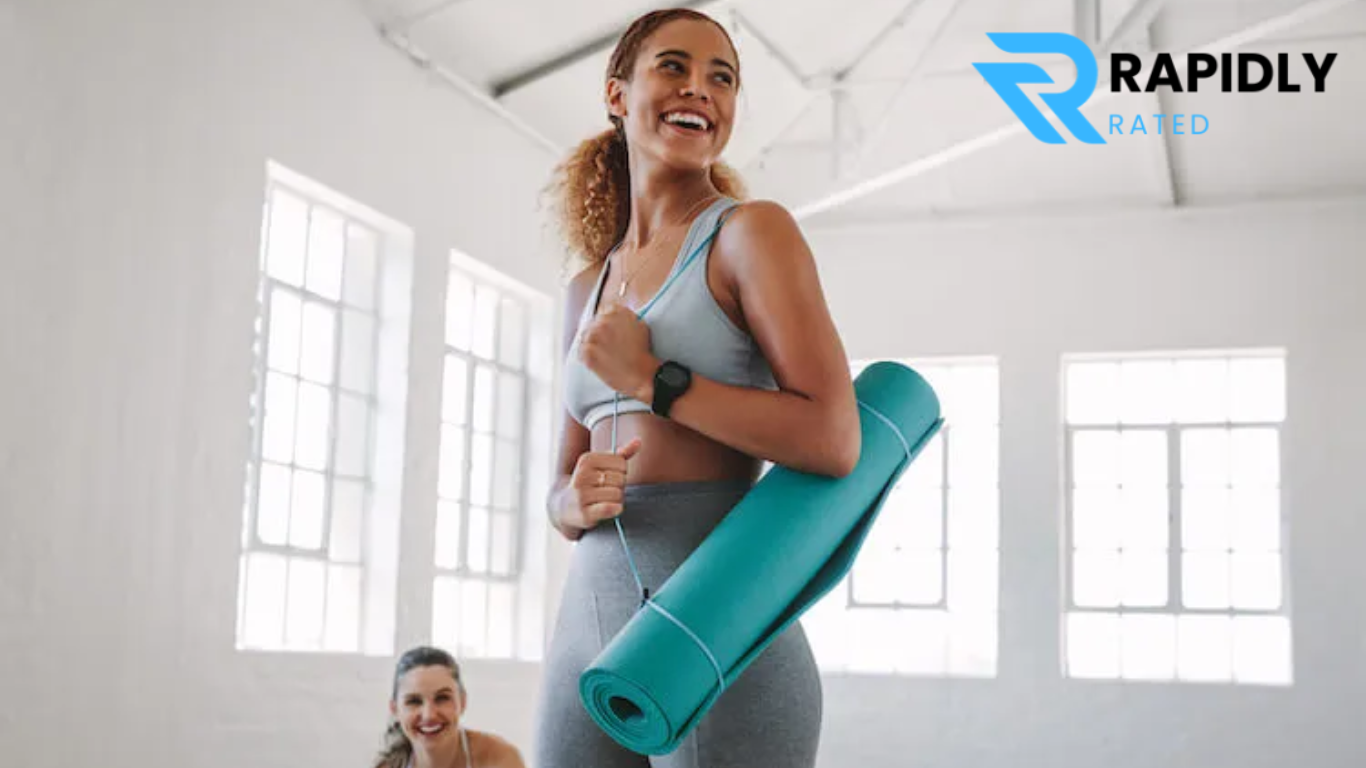Yoga feels like the perfect choice as your adventure begins. Fantastic! No matter what your purpose is, yoga offers a valuable and pleasurable physical activity.
You need to understand yoga basics before you begin your practice on the mat. This article guides you step by step through yoga essentials and accessible starting poses.
Why Yoga?
Yoga isn’t just about bending and stretching; it’s a lifestyle shift that brings a ton of benefits. Here’s why you’ll love it:
- Boosts Flexibility & Strength – No, you don’t need to be naturally bendy. That’s why you start!
- Reduces Stress & Anxiety – Deep breathing + movement = a calmer you.
- Improves Posture & Balance – Perfect for counteracting those hours hunched over a screen.
- Enhances Overall Well-Being – Helps with digestion, sleep, and even mental clarity.
Now that you’re excited, let’s talk about what you need to start your yoga journey.
Essential Yoga Gear for Beginners
Before diving into poses, let’s ensure you have the right setup. You don’t need a ton of fancy equipment, but a few key pieces will make your practice more comfortable and enjoyable.
1. Yoga Mat
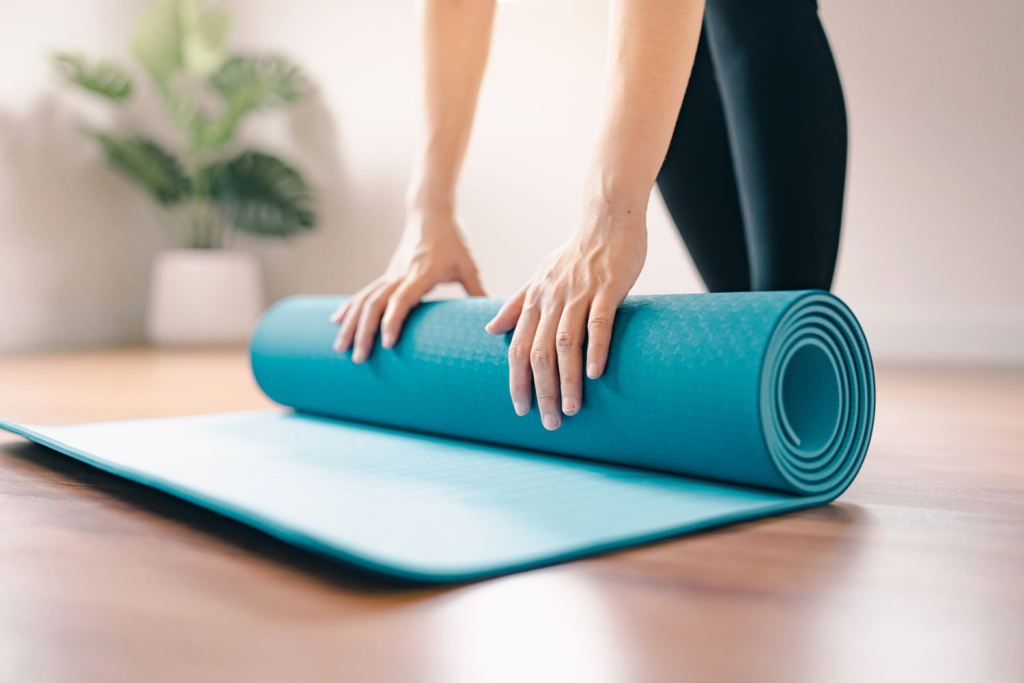
The holy grail of yoga essentials! A good yoga mat provides:
- Grip & Stability – So you’re not slipping and sliding mid-pose.
- Cushioning – Protects your joints from hard floors.
- Personal Space – Your little yoga sanctuary, no matter where you are.
Pro Tip: Go for a non-slip, eco-friendly, and at least ¼-inch thick mat for the best experience.
Recommendations:
- AmazonBasics 1/2 Inch Extra Thick Exercise Yoga Mat with Carrying Strap
- Gaiam Essentials Premium Yoga Mat with Yoga Mat Carrier Sling (72″L x 24″W x 1/4 Inch Thick)
- Manduka PROlite Yoga Mat – Teacher Recommended, Non-Slip Textured 4.7mm Ultra-Dense, Hot Yoga Workout, Studio at Home Pilates
- Gaiam Essentials Thick Yoga Mat Fitness & Exercise Mat with Easy-Cinch Yoga Mat Carrier Strap, 72″L x 24″W x 2/5 Inch Thick
- Gruper Yoga Mat Non Slip, Eco Friendly Fitness Exercise Mat with Carrying Strap,Pro Yoga Mats for Women,Workout Mats for Home, Pilates and Floor Exercises
2. Comfortable Clothing
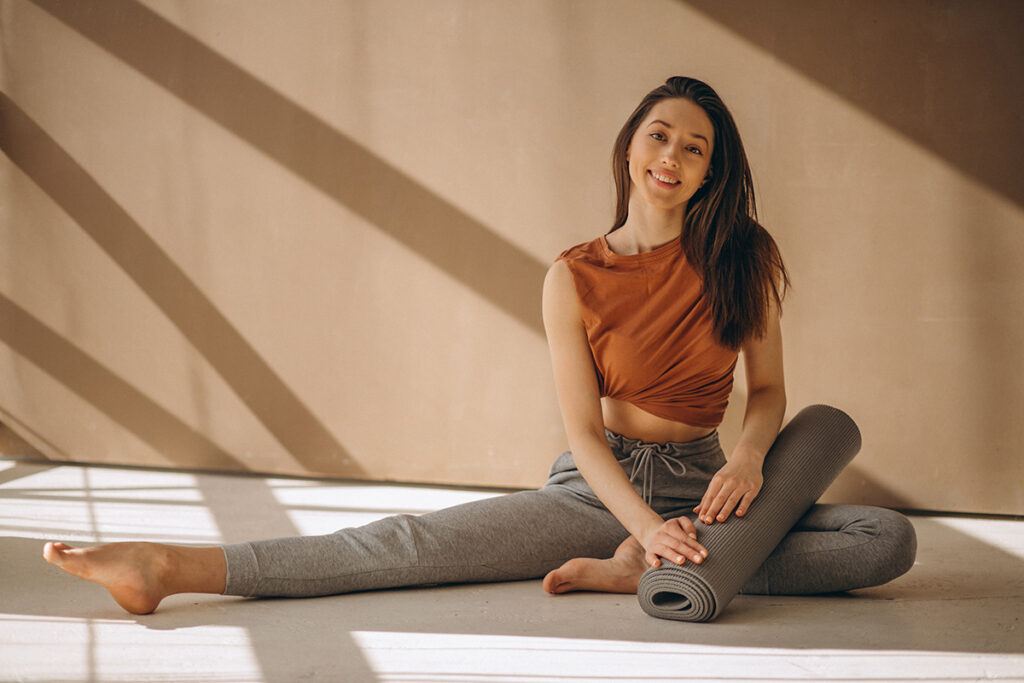
Skip the baggy T-shirts and stiff jeans! Opt for:
- Breathable Leggings or Shorts – Allows movement without restrictions.
- Fitted, Stretchy Tops – So your shirt doesn’t fly over your head in downward dog.
- Sports Bra (for women) – Extra support, especially for flow-based yoga.
Recommendations:
- ODODOS Women’s Tummy Control Yoga Shorts 2.0 with Pockets High Waist Athletic Workout Shorts-5″ / 8″ / 10″ Inseam
- CADMUS High Waist Athletic Shorts for Womens Yoga Fitness Running Shorts with Deep Pockets
- Buauty 2/3 Pack Biker Shorts Women Tummy Control with Pocket 8″ High Waisted Yoga Running Workout Spandex Compression Shorts
- NELEUS Women’s Running Crop Tank Tops Dry Fit Workout Athletic Crop Shirts Pack of 3
- ODODOS Women’s Crop 3-Pack Seamless Rib-Knit Camisole Crop Tank Tops
3. Yoga Blocks

These foam or cork blocks are game-changers for beginners. They help by:
- Providing support in balancing poses
- Making stretches more accessible
- Assisting in proper alignment
Recommendations:
- Gaiam Yoga Block – Supportive Latex-Free Eva Foam – Soft Non-Slip Surface with Beveled Edges for Yoga, Pilates, Meditation – Yoga Accessories for Stability, Balance, Deepen Stretches
- Trideer Yoga Block, Soft Non-Slip Surface Premium Foam Blocks, Supportive, Lightweight, Odor Resistant, Yoga Accessories for Pilates Meditation General Fitness Stretching Toning
- IUGA Yoga Blocks 2 Pack With Strap Non Slip High Density 9″x6″x3″ Solid & Cork Yoga Block With Yoga Strap to Improve Strength Balance for Yoga Pilates Meditation
- Manduka Yoga Block – Fine-Grain Cork Block, Yoga Equipment, Home Gym Accessory, Pilates Tool, Lightweight for Travel, Extra Firm Workout Accessory with Comfortable Edges
- Overmont Yoga Block 2 Pack Supportive Latex-Free EVA Foam Soft Non-Slip Surface for General Fitness Pilates Stretching and Meditation 9″x6″x3″ Yoga Strap Included
4. Yoga Strap
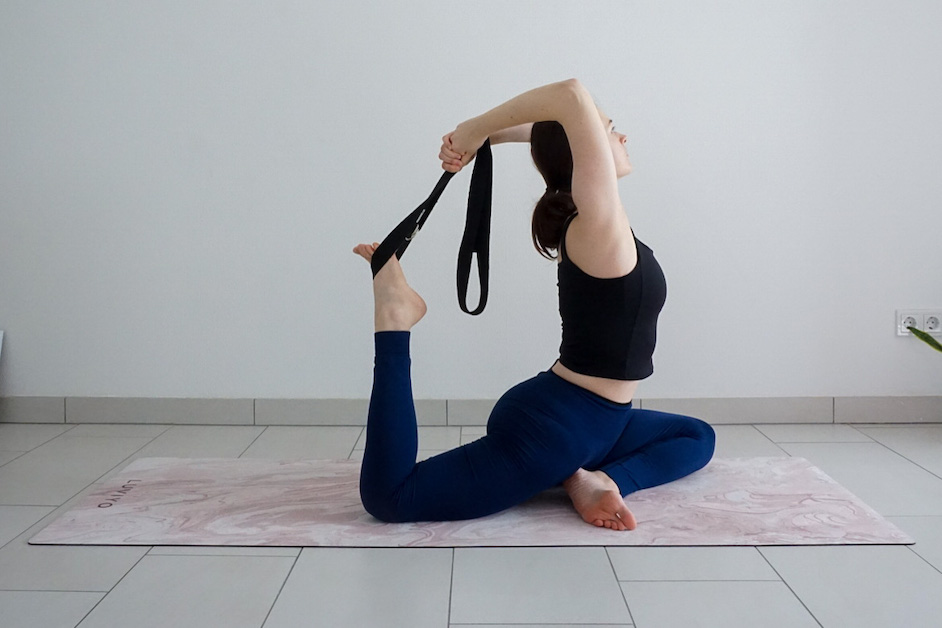
Not the most glamorous tool, but super helpful! A yoga strap helps:
- Improve flexibility
- Support deeper stretches
- Assist with alignment and posture
Recommendations:
- Tumaz Yoga Strap/Stretch Bands [15+ Colors, 6/8/10 Feet Options] with Extra Safe Adjustable D-Ring Buckle, Durable and Comfy Delicate Texture – Best for Daily Stretching, Physical Therapy, Fitness
- Slim Panda Yoga Strap for Stretching, (10+ Colors,6 Feet/8 Feet) Yoga Bands with Adjustable D-Ring Buckle, Cotton Yoga Belt for Fitness, Yoga, Pilates, Physical Therapy, Improve Flexibility
- Stretching Strap Yoga Strap with Loops, Stretch Straps for Physical Therapy, Non-Elastic Exercise Strap for Pilates, Dance and Gymnastics with Workout Guide
- Trideer Stretching Strap Yoga Strap Physical Therapy for Home Workout, Exercise, Pilates and Gymnastics, 10 Loops Non-Elastic Stretch Bands with Aesthetic Packaging for Women & Men
- Gaiam Yoga Strap Premium Athletic Stretch Band with Adjustable Metal D-Ring Buckle Loop | Exercise & Fitness Stretching for Yoga, Pilates, Physical Therapy, Dance, Gym Workouts
5. Water Bottle
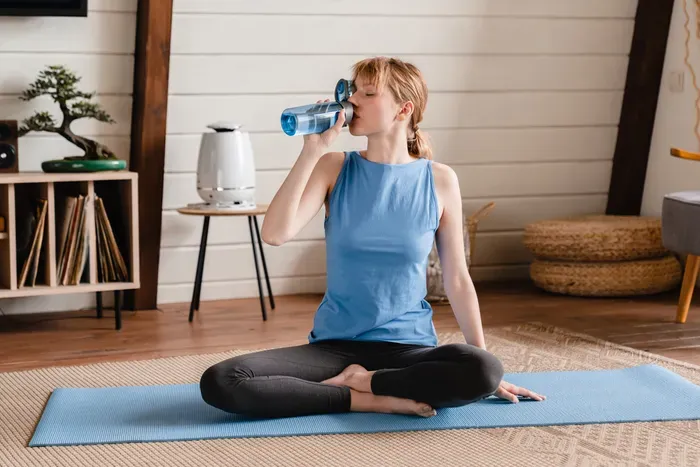
Yoga can be sweatier than you think, especially if you’re doing Vinyasa or Power Yoga. Stay hydrated!
Recommendations:
- Owala FreeSip Insulated Stainless Steel Water Bottle with Straw for Sports, Travel, and School BPA-Free Sports Water Bottle, 32 oz, Shy Marshmallow
- BOTTLE BOTTLE 32 oz Insulated Water Bottle Stainless Steel Sport Water Bottle with Straw Dual-use Lid Design for Gym with Pill Box (green)
- Stainless Steel Water Bottle with Straw, Infuser & 3 Lids: 18/32 OZ Leak-Proof Vacuum Insulated ACTIVE FLASK Drinking Bottles Hot Cold: Double Walled Outdoor Drink Thermo Mug Tea Coffee Sport Gym Bike
- Simple Modern Water Bottle with Straw and Chug Lid Vacuum Insulated Stainless Steel Metal Thermos Bottles | Reusable Leak Proof BPA-Free Flask for Sports | Summit Collection | 32oz, Almond Birch
- Aqulea Glass Water Bottles 32 Oz with Silicone Sleeve – BPA Free Reusable Wide Mouth Glass Motivational Water Bottles with Fruit Infuser – Leak Proof Borosilicate Water Bottle with Time Marker (Green)
6. Meditation Cushion (Optional)
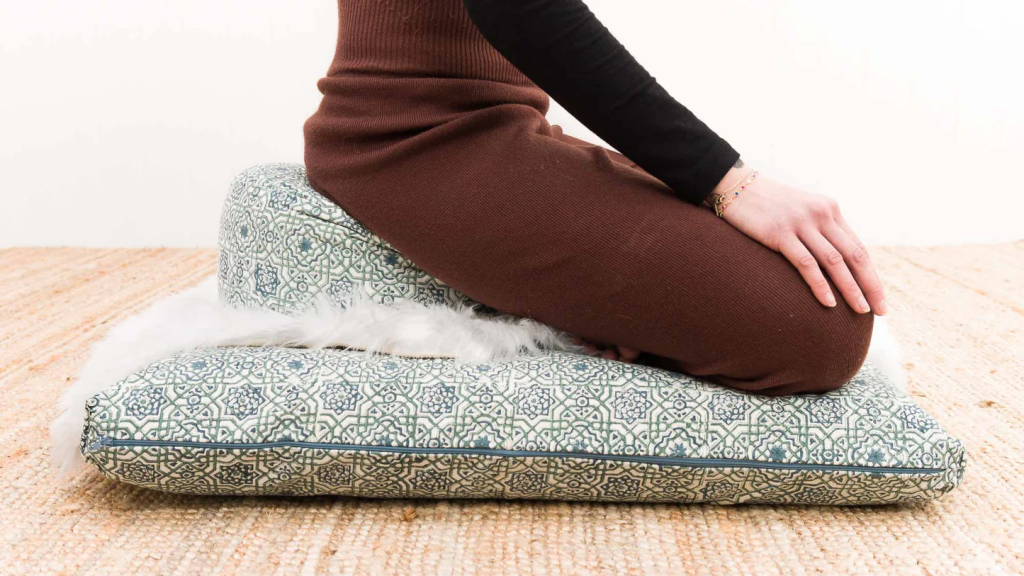
If you’re planning to include meditation in your practice, a cushion can help make sitting comfortably easier for longer periods.
Recommendations:
- Florensi Meditation Cushion – Comfortable Floor Pillow – Traditional Tibetan Meditation Pillow with Beautiful Velvet Cover – Large Floor Cushion Seating for Adults – Premium Yoga Buckwheat Bolster
- Gaiam Yoga Bolster – Long, Rectangular Meditation Pillow – Supportive Cushion for Restorative Yoga and Sitting on the Floor – Built-In Carrying Handle – Machine Washable Cover’
- Retrospec Retrospec Sequoia Rectangular Yoga Bolster Pillow – Meditation Cushion for Yoga Practices – Includes Machine Washable 100% Cotton Cover & Durable Carry Handle
- Hihealer Meditation Cushion – Large Velvet Zafu Floor Pillow for Adults and Women – Comfortable Yoga Pillow with Traditional Tibetan Buckwheat Filling for Meditation and Relaxation
- Retrospec Sedona Zafu Yoga Meditation Cushion
Beginner-Friendly Yoga Sets
Now that you have the right gear, it’s time to dive into some easy yoga sequences that will introduce you to the practice. Here are three beginner-friendly yoga sets focusing on flexibility, relaxation, and strength.
Set 1: Morning Energizing Flow (10-15 minutes)
This sequence is perfect for starting your day with energy and focus.
- Mountain Pose (Tadasana) – Stand tall, inhale deeply, and ground yourself.
- Upward Salute (Urdhva Hastasana) – Stretch your arms overhead for a morning wake-up.
- Forward Fold (Uttanasana) – Loosen your hamstrings and spine.
- Cat-Cow Stretch – Warm up your spine with gentle movements.
- Downward Dog (Adho Mukha Svanasana) – Engage your full body in a mild stretch.
- Warrior I (Virabhadrasana I) – Strengthen your legs and build confidence.
- Child’s Pose (Balasana) – End with relaxation and deep breathing.
Set 2: Evening Wind-Down Yoga (15-20 minutes)
Perfect for releasing stress and tension after a long day.
- Seated Forward Fold (Paschimottanasana) – Relax your spine and stretch your legs.
- Butterfly Pose (Baddha Konasana) – Open up your hips and ease tension.
- Legs-Up-The-Wall Pose (Viparita Karani) – Improve circulation and calm the nervous system.
- Supine Twist – Release back tension and improve digestion.
- Savasana (Corpse Pose) – The ultimate relaxation pose; just breathe and let go.
Set 3: Strength-Building Flow (15 minutes)
A gentle introduction to building core and muscle strength.
- Plank Pose – Strengthen your core and arms.
- Chair Pose (Utkatasana) – Engage your legs and improve stability.
- Low Lunge (Anjaneyasana) – Stretch and strengthen simultaneously.
- Cobra Pose (Bhujangasana) – Open up the chest and strengthen the back.
- Bridge Pose (Setu Bandhasana) – Strengthen your glutes and spine.
- Savasana – End with relaxation.
Pro Tips for Starting Your Yoga Journey
1. Start Slow and Listen to Your Body
Yoga is about mindfulness. Don’t push yourself too hard. If a pose feels painful, modify it or take a break.
2. Breathe, Breathe, Breathe!
Yoga isn’t just about the poses; it’s also about breathwork. Focus on deep, controlled breathing to enhance relaxation and endurance.
3. Be Consistent
Practicing yoga 2-3 times a week can show results quickly. It’s better to have short, consistent sessions than to overdo it once in a while.
4. Follow Guided Sessions
New to yoga? Follow YouTube videos or join a beginner class to learn correct postures and sequences.
5. Don’t Compare Yourself to Others
Flexibility and strength improve over time. Focus on your journey rather than what others can do.
6. Enjoy the Process
Yoga is about self-care. Make it fun, experiment with different poses, and find what works best for you.
Common Beginner Mistakes & How to Avoid Them
❌ Holding Your Breath
Fix: Focus on slow, deep breathing in every pose.
❌ Comparing Yourself to Others
Fix: Yoga is personal! Progress at your own pace.
❌ Skipping Warm-Up & Cool-Down
Fix: Always ease into and out of your practice to prevent injury.
❌ Forcing Flexibility
Fix: Use props and modifications. Progress comes with time!
Final Thoughts:
Yoga isn’t about being perfect; it’s about practice. Start with short sessions, listen to your body, and enjoy the journey.
Over time, you’ll build strength, flexibility, and a sense of calm that makes yoga totally worth it. So grab your mat, strike a pose, and have fun with it!
Frequently Asked Questions (FAQs)
1. How often should beginners do yoga?
Beginners should aim for 2-3 times a week to build consistency and flexibility.
2. Do I need to be flexible to start yoga?
No! Yoga helps improve flexibility over time, so just start where you are.
3. What type of yoga is best for beginners?
Hatha and Vinyasa yoga are great choices for beginners due to their slow, controlled movements.
4. Can I do yoga at home?
Yes! There are plenty of online classes and tutorials to guide you through practice.
5. What should I eat before yoga?
Eat light—fruit, nuts, or a smoothie—about an hour before your session.

